Xylophanes porcus continentalis
|
|
Updated as per
AN ANNOTATED CHECKLIST OF THE SPHINGIDAE OF BOLIVIA, October 2007
Updated as per personal communication with Gregory Nielsen (Villavicencio, Meta, Colombia, January 15, September 18, 2011, 500m); February 8, September 21, 2011
Updated as per CATE (Para, Brazil; description); February 8, 2011
Updated as per "A Hawk Moths fauna of southern Maranhão state, Brazil, ... "; NEVA: Jahrgang 34 Heft 3 November 2013; via Jean Haxaire; April 5, 2014
Updated as per personal communication with Ezequiel Bustos (Shilap revta. lepid. 43 (172) diciembre, 2015, 615-631 eISSN 2340-4078 ISSN 0300-5267), January 4, 2016
Updated as per personal communication with Gernot Kunz (El Copan, Cartago, Costa Rica, March 6, 2019, 1047m); April 17, 2019
|
Xylophanes porcus continentalis
zail-AH-fan-ees
MPOR-kusMkon-tih-nen-TAGHL-ihs
Rothschild & Jordan, 1903

Xylophanes porcus continentalis courtesy of John Vriesi.

Xylophanes porcus continentalis, Altagracia, Rivas, Nicaragua,
July 14, 2005, courtesy of Mike Simpson, id by Bill Oehlke

Xylophanes porcus continentalis, El Copan, Cartago, Costa Rica,
March 6, 2019, 1047m, courtesy of Gernot Kunz.
The specimen directly above could also be nominate porcus or an undescribed porcus subspecies. Dan Janzen is strongly suggesting two or more porcus subspecies in
Costa Rica, but they remain unnamed and unconfirmed as of April 2019.
This site has been created by
Bill Oehlke
Comments, suggestions and/or additional information are welcomed by Bill.
TAXONOMY:
Family: Sphingidae, Latreille, 1802
Subfamily: Macroglossinae, Harris, 1839
Tribe: Macroglossini, Harris, 1839
Genus: Xylophanes Hubner [1819] ...........
Species: porcus continentalis Rothschild & Jordan, 1903
|
DISTRIBUTION: Xylophanes porcus
continentalis moths (wingspan: approx. 70mm) fly in
Colombia (specimen type locality): Meta (GN) and
across northern South America
to
French Guiana; and
Brazil: Para (CATE); southern Maranhao. They are also recorded as far south as
Bolivia: Santa Cruz;
Argentina: Misiones (EB);
and as far north as Mexico and
Belize, and probably fly throughout Central America.
Xylophanes porcus continentalis in resting position typical of
species in the Xylophanes genus. |
 |
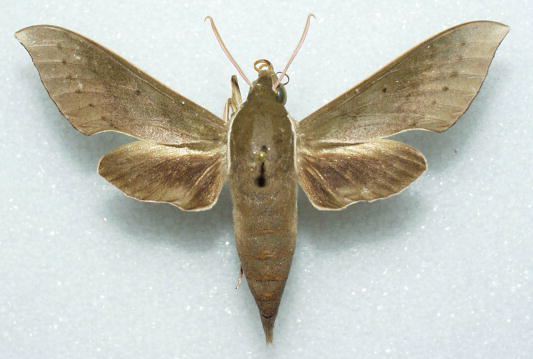
Xylophanes porcus continentalis, Mexico, courtesy of Manuel
Balcazar-Lara.
The subspecies continentalis is very similar to the nominate species Xylophanes porcus porcus, but the stigma is slightly smaller,
the postmedian olive-green cloud is less distinct, and the submarginal row of small dots is slightly more pronounced. CATE
In the female, the forewing apex is not as produced as in the male, but the outer margin is quite convex below the slightly hollowed out region below the apex,
in contrast to the male where the same area is only slightly convex.
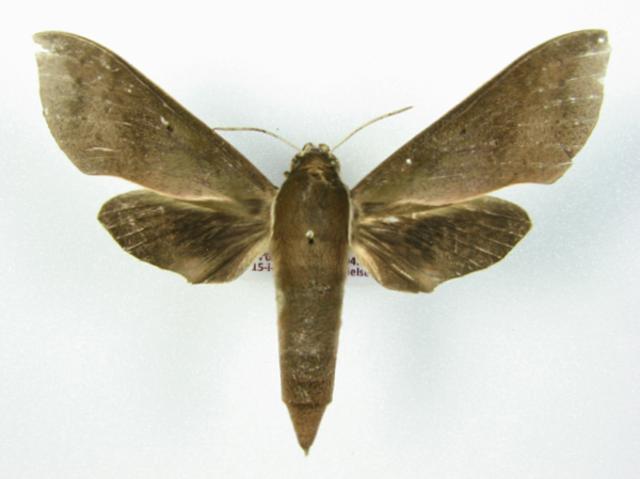
Xylophanes porcus continentalis female, Villavicencio, 04°03’55.0 N 073°41’87.0 W, Meta, Colombia,
January 15, 2011, 500m, courtesy of Gregory Nielsen,
id courtesy of Jean Haxaire and Ian Kitching.
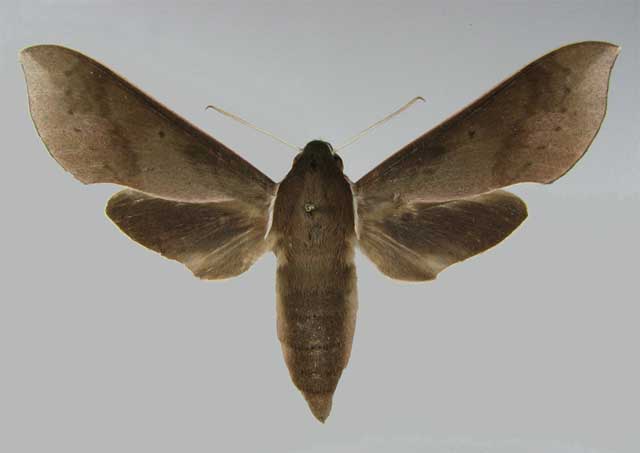
Xylophanes porcus continentalis female, Villavicencio, 04°03’55.0 N 073°41’87.0 W, Meta, Colombia,
September 18, 2011, 500m, LFW 39mm, courtesy of Gregory Nielsen
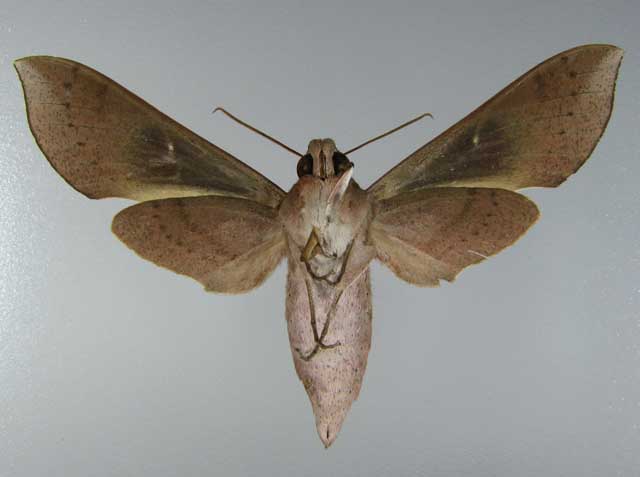
Xylophanes porcus continentalis female (verso), Villavicencio, 04°03’55.0 N 073°41’87.0 W, Meta, Colombia,
September 18, 2011, 500m, LFW 39mm, courtesy of Gregory Nielsen
The pronunciation of scientific names is
troublesome for many. The "suggestion" at the top of the page is
merely a suggestion. It is based on commonly
accepted English pronunciation of Greek names and/or some
fairly well accepted "rules" for latinized scientific names.
The suggested pronunciations, on this page and on other pages,
are primarily put forward to assist those who hear with internal
ears as they read.
There are many collectors from different countries whose
intonations and accents would be different.
Jean Marie Cadiou writes, "When I say "Xylophanes" in English I
pronounce it something like "Zailophanees", with the emphasis on the
"o". The French pronounce it differently, something like
"Kzeelophaness" with no emphasis, and the Germans yet in a
different way..."
Some of the early describers/namers chose genus
and species names indicating some character of the insect, but more
often, they simply chose names from Greek or Roman mythology or
history.Those species names which end in "ensis" indicate a
specimen locale, and those which end in "i", pronounced "eye", honour
a contempory friend/collector/etc.
In Greek myth, Phanes is the golden winged Primordial Being who
was hatched from the shining Cosmic Egg that was the source of the
universe. He personifies light emerging from chaos.
"Xylo" is the Greek word for wood.
The specimen type for the genus
Xylophanes is Xylophanes anubus. Perhaps ? when Hubner
examined that species, the yellow-orange and brown tones of the
forewings suggested wings of wood.
"Porcus" is the Latin word for pig, possibly chosen for the pig-skin
colouration of the moth, and "continentalis" is possibly chosen for
the widespread distribution of this moth across South America.
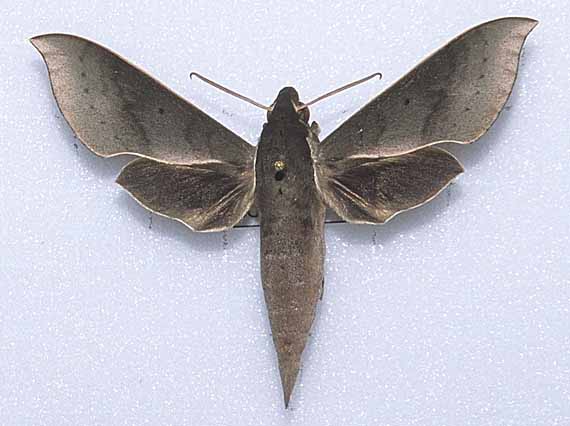
Xylophanes porcus continentalis male courtesy of
Hubert Mayer
copyright.
FLIGHT TIMES:
Xylophanes porcus continentalis adults fly in April near Kaw, French Guiana. This species probably broods continuously.
Gregory Nielsen reports them on the wing in January and September in Villavicencio, Meta, Colombia.
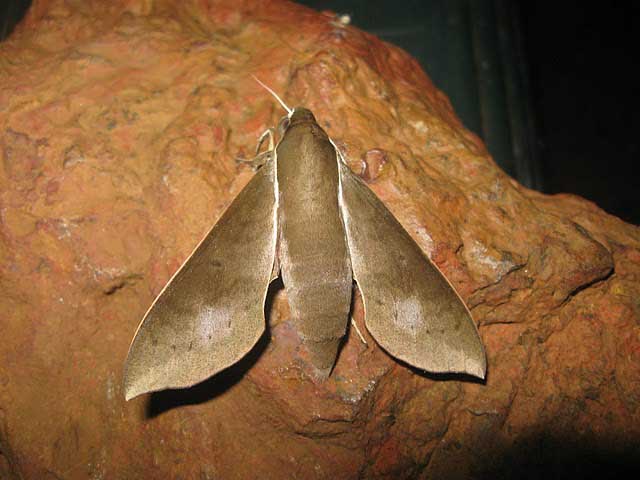
Xylophanes porcus continentalis female, Camp Caiman, near Kaw, French Guiana,
April 1, 2011, courtesy of Andres Urbas.
ECLOSION:
Pupae probably wiggle to surface from subterranean chambers just prior to eclosion.
SCENTING AND MATING:Females call in the males with a pheromone released from a gland at the tip of the
abdomen. Males come in to lights very readily, but females are seldom taken in that way.
EGGS, LARVAE, PUPAE:
Larvae probably feed on
members of the Rubiaceae or Malvaceae families.
Moths emerge approximately one-two months after larvae pupate.
Use your browser "Back" button to return to the previous page.
Goto Main Sphingidae Index
Goto Macroglossini Tribe
Goto Central American Indices
Goto Carribean Islands
Goto South American Indices
Goto U.S.A. tables









